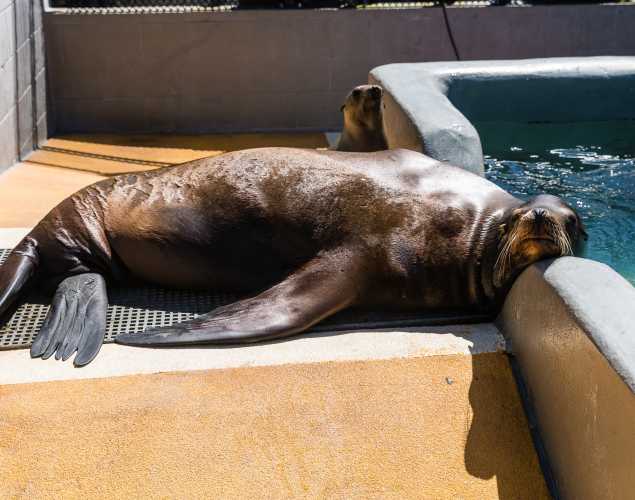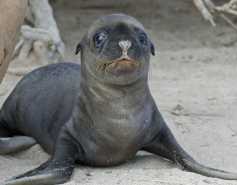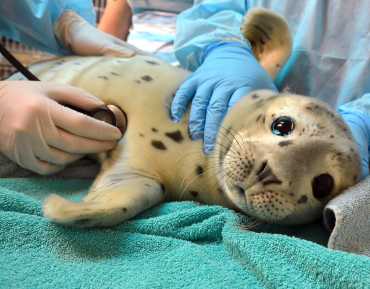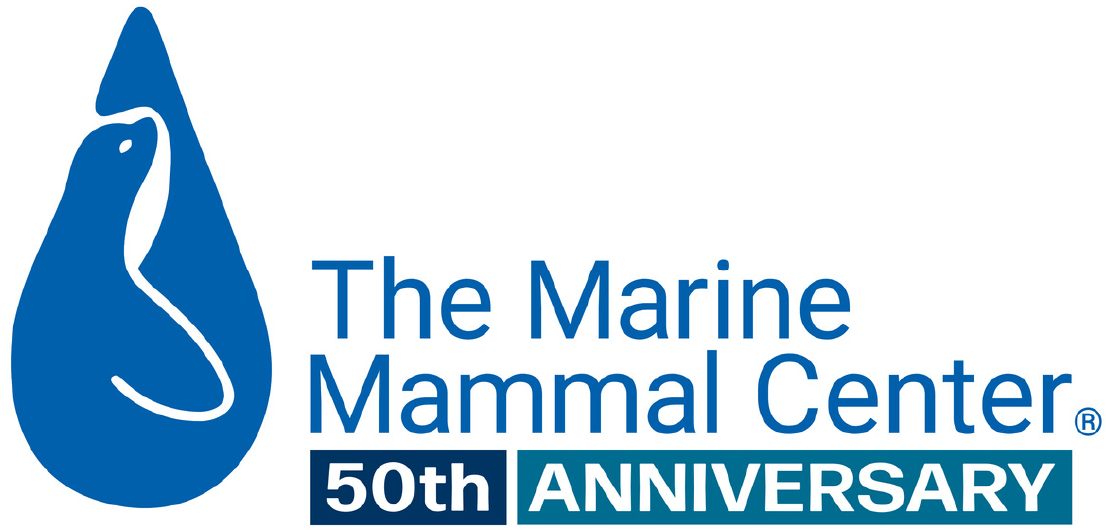
Another Sea Lion Crisis Underway as Toxic Algal Bloom Grows
- Domoic acid
September 3, 2015
California sea lions are having a tough year. Starting in late 2014, starving sea lion pups that should have been nursing with their mothers on the Channel Islands began stranding along the California coast in record numbers.
By June, The Marine Mammal Center had rescued more than 1,100 sea lions—and nearly every one arrived looking like a “bag of bones,” as Dr. Shawn Johnson, Director of Veterinary Science, puts it. These pups were literally starving to death, and many did not survive.
Experts believe that unusually warm waters along the coast this year caused fish populations to shift, making it harder for nursing sea lion mothers on the Channel Islands to forage for food nearby and causing them to abandon their pups in search of sustenance.
Now California sea lions seem to be having the opposite problem—they’re finding the food sources they need, but unfortunately these fish are contaminated with a neurotoxin called domoic acid.
A Toxic Meal
Produced by a type of algae called Pseudo-nitzschia australis, this toxin accumulates in small fish, like sardines and anchovies, which are then eaten by sea lions in large quantities. So the hearty meals that should be nourishing the once-starving sea lions are instead making them deathly ill.
About three-quarters of the California sea lions at our hospital are suffering from domoic acid toxicity, which primarily attacks the brain, causing lethargy, disorientation, seizures and if not treated, eventually, death.
Unfortunately, it’s a diagnosis we know well here at the Center. In fact, researchers here were the first to discover the condition in sea lions back in 1998. And we’ve had plenty of opportunities to learn more since then—just last year, more than one-third of the California sea lions we rescued were affected by the toxin.
Domoic acid will naturally flush from an animal’s system over time, but sea lions exposed to the toxin over a long period of time will suffer longer-lasting and more serious effects. If these animals come into our care before significant damage occurs, we are often able to help flush the toxin from their systems by giving them fluids. We also provide them with a fish source that is free of domoic acid. To control any seizures, our veterinarians give these patients phenobarbital, an anti-seizure medication that is also used in humans.
This year, our researchers are also testing the effectiveness of adding alpha lipoic acid to our domoic acid toxicity treatment regimen. This powerful antioxidant may help protect against damage to the brain by preventing the toxin from binding to certain receptors in the tissue. And because it is both water- and fat-soluble, alpha lipoic acid is absorbed into a greater variety of tissue types, which means it can pass easily into the brain tissue as well as help prevent cell damage throughout the whole body.
Our veterinary experts are monitoring our patients on this new protocol, anticipating faster recovery times and reduced brain injury. When they see marked changes in behavior over time, they know the animal is ready to go back to the ocean. A sea lion that was once lethargic, disoriented and uninterested in fish will become alert, active and eager to eat—a visual reminder of the importance of the work we’re doing.
“The most rewarding part of our work is seeing a healthy animal return to the wild with a second chance at life,” Dr. Johnson says. Just this week, we spotted one of our former patients in the wild, a juvenile California sea lion named Devil Ray that had been treated for domoic acid toxicity in 2010. Five years later, he’s full-grown—sporting the characteristic sagittal crest, or raised forehead, of an adult male—and is likely a father as well.
This year, many of the patients we’re treating for domoic acid toxicity are adult females that are lactating, meaning that they likely abandoned their pups on the Channel Islands after giving birth in June. These orphaned pups would be just a few months old and still dependent on their mother’s milk, so they are unlikely to survive.
So far this year, we’ve rescued more than 180 sea lions suffering from domoic acid toxicity, but we may only be seeing a small number of the animals affected by the current toxic algal bloom. Mother sea lions that are still on the Channel Islands could be unknowingly passing the toxin along to their pups. Researchers at the Center published a study just last year showing that domoic acid can be detected in a mother’s milk, even weeks after the toxin has been ingested.
Domoic Acid Toxicosis Research at The Marine Mammal Center
The Marine Mammal Center diagnosed the first case of domoic acid poisoning in marine mammals because of a large outbreak in California sea lions in 1998. Since then, our veterinarians and scientists have contributed to a number of scientific papers on domoic acid poisoning.
{"image":"\/Animals\/Wild\/California sea lion\/cropped-images\/sea-lion-pup-shutterstock-451-142-3018-2358-1603915228.jpg","alt":"California sea lion pup","title":"Domoic Acid in Fetal Fluids of California Sea Lions","link_url":"https:\/\/www.marinemammalcenter.org\/publications\/domoic-acid-in-fetal-fluids-of-california-sea-lions","label":"Research Paper","type":"publication"}

{"image":"\/Animals\/Wild\/Steller sea lion\/cropped-images\/steller-sea-lion-harem-shutterstock-648-0-4424-3456-1603916879.jpg","alt":"Group of Steller sea lions","title":"Algal Toxins in Alaskan Marine Mammals Foraging in a Changing Environment","link_url":"https:\/\/www.marinemammalcenter.org\/publications\/algal-toxins-in-alaskan-marine-mammals-foraging-in-a-changing-environment","label":"Research Paper","type":"publication"}

{"image":"\/Animals\/Patients\/California sea lions\/cropped-images\/csl-by-bill-hunnewell-c-the-marine-mammal-center-2-0-1031-1794-1401-1603916128.jpg","alt":"California sea lion","title":"Evaluating Sense of Smell in California Sea Lions and Relevance to Domoic Acid","link_url":"https:\/\/www.marinemammalcenter.org\/publications\/evaluating-sense-of-smell-in-california-sea-lions-and-relevance-to-domoic-acid","label":"Research Paper","type":"publication"}

Evaluating Sense of Smell in California Sea Lions and Relevance to Domoic Acid
Read More{"image":"\/Places\/Coastal landscapes\/cropped-images\/algal-bloom-washington-state-shutterstock-159-0-3840-3000-1603917390.jpg","alt":"algal bloom off the coast of Washington state","title":"Unprecedented Toxic Algal Bloom Linked to Unusual Ocean Conditions","link_url":"https:\/\/www.marinemammalcenter.org\/publications\/unprecedented-toxic-algal-bloom-linked-to-unusual-ocean-conditions","label":"Research Paper","type":"publication"}

A Record-Breaking Bloom
Scientists say the current algal bloom along the Pacific coast is the biggest and most toxic they’ve ever seen. The massive bloom is estimated to be about 40 miles wide and extends from southern California north all the way to Alaska. Scientists have been able to verify the presence of the algal bloom down to 45 feet, but according to sonar readings, in some places it could reach a depth of more than two football fields.
Researcher Anthony Odell of the University of Washington’s harmful algal bloom monitoring program has described the bloom as a “toxic plankton soup” because it consists of several species of harmful algae. And it appears that a number of hot spot blooms that typically appear each spring are merging for the first time.
Unfortunately, this bloom also seems to be persisting longer than usual—it’s been expanding since May. Although we are just starting to see an influx of sea lions affected by domoic acid, the toxin has been impacting other species since spring.
Public health officials found dangerously high levels of domoic acid in anchovies, causing a closure of that fishery earlier this year. Officials in California, Oregon and Washington have also implemented warnings or closures on sardines, shellfish and crab in affected areas, causing economic ripple effects up and down the coast.
Researchers say the toxins released from this massive algal bloom are working their way into the food chain in ways they’ve never seen before.
Although most of the patients we treat for domoic acid toxicity are California sea lions, other marine mammals are susceptible to its effects as well. Domoic acid has been reported in a number of other seal and sea lion species, as well as cetaceans such as blue and humpback whales. Just last year, researchers at the Center were the first to detect domoic acid in Guadalupe fur seals, a threatened species.
Domoic acid can also affect humans who eat contaminated shellfish, causing a life-threatening condition known as amnesiac shellfish poisoning. Because sea lions are often the first to be affected by a toxic algal bloom, we alert the public health department when we see an outbreak, which helps them to better target their surveillance to protect human health.
Still Searching for Answers
Through testing and closing dangerous fisheries, we’ve gotten better at preventing humans from getting sick from domoic acid, but these efforts don’t work for marine mammals. And there’s still a lot we don’t know about what causes massive algal blooms like the one we’re seeing now—or even why the Pseudo-nitzschia algae produces the toxin.
Right now, a team of researchers is on a NOAA research ship en route from southern California to Canada hoping to answer some of these key questions. They are looking at concentrations of domoic acid along the way to help determine what might have triggered the bloom.
Although the research trip is scheduled to end this month, it could take some time before scientists are able to determine what may be causing the toxic algal bloom and what it could mean for our ocean.
One thing we do know is that the algae seems to be thriving in the unusually warm waters off the West Coast—and with El Niño in effect, those warm water temperatures are likely to continue. However, researchers are hopeful that some of the big coastal storms expected this fall will churn up the waters enough to disperse the nutrients that allow the algae to thrive.
Either way, The Marine Mammal Center is bracing for another busy season. “We continue to rescue animals affected by this toxin every day and realize we may continue to see the impacts of this bloom for months to come,” Dr. Johnson says. “As ocean conditions continue to deteriorate, this is just one of the many challenges facing marine life.”
Yes, I want to save a life!

Yes, I want to save a life!
You’ll be giving sick and injured animals the best possible care at the Center’s state-of-the-art hospital. With your gift today, you are giving a patient a second chance at life in the wild.
See Our Latest News
{"image":"\/Animals\/Wild\/California sea lion\/cropped-images\/csl-release-4-5-24photo-by-chris-deimler-c-the-marine-mammal-center-138-0-1270-992-1745348188.jpg","alt":"Four young California sea lions walk on the beach toward the ocean.","title":"Achievements in Ocean Health","link_url":"https:\/\/www.marinemammalcenter.org\/news\/achievements-in-ocean-health","label":"News Update","date":"2025-04-23 10:20:00"}

{"image":"\/Misc\/Graphics\/cropped-images\/climate-change-graphic-giant-earth-shutterstock-1798-6-5113-3994-1680046432.jpg","alt":"An Earth Day graphic of people holding the planet, recycling, planting a tree and moving a solar panel.","title":"5 Ways to Celebrate Earth Day","link_url":"https:\/\/www.marinemammalcenter.org\/news\/5-ways-to-celebrate-earth-day","label":"News Update","date":"2025-04-18 11:21:08"}

{"image":"\/Animals\/Wild\/Sea otter\/cropped-images\/sea-otter-mom-pup-photo-c-brian-simuro-505-0-3387-2646-1618247266.jpg","alt":"sea otter mother and pup","title":"Meaningful Mother\u2019s Day Gifts for Ocean Lovers","link_url":"https:\/\/www.marinemammalcenter.org\/news\/eco-friendly-mothers-day-gifts-that-give-back","label":"News Update","date":"2025-04-10 02:00:00"}

{"image":"\/Animals\/Wild\/Harbor seal\/cropped-images\/harbor-seals-shutterstock-107-0-1270-992-1744225508.jpg","alt":"A group of harbor seal pups and mothers on the beach during pupping season.","title":"Your Guide to Seeing Harbor Seal Pups in California","link_url":"https:\/\/www.marinemammalcenter.org\/news\/your-guide-to-seeing-harbor-seal-pups-in-california","label":"News Update","date":"2025-04-10 00:00:00"}

California Sea Lion
